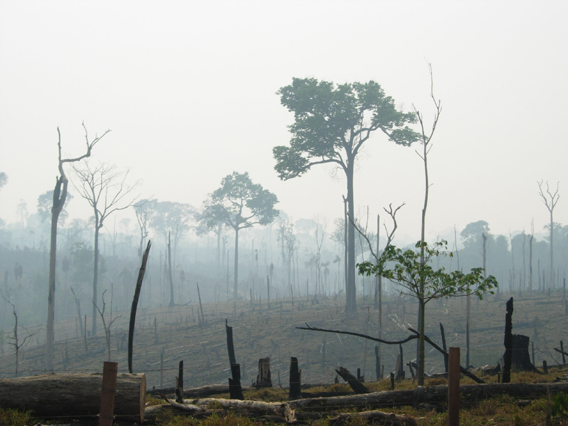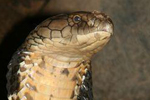- Once habitat is lost or degraded, a species doesn’t just wink out of existence: it takes time, often several generations, before a species vanishes for good.
- A new study in Science investigates this process, called “extinction debt”, in the Brazilian Amazon and finds that 80-90 percent of the predicted extinctions of birds, amphibians, and mammals have not yet occurred.
- But, unless urgent action is taken, the debt will be collected, and these species will vanish for good in the next few decades.

Burnt forest in the Amazon. Photo by: Alexander Lees.
Once habitat is lost or degraded, a species doesn’t just wink out of existence: it takes time, often several generations, before a species vanishes for good. A new study in Science investigates this process, called “extinction debt”, in the Brazilian Amazon and finds that 80-90 percent of the predicted extinctions of birds, amphibians, and mammals have not yet occurred. But, unless urgent action is taken, the debt will be collected, and these species will vanish for good in the next few decades.
“This time delay offers a window of conservation opportunity, during which it is possible to restore habitat or implement alternative measures to safeguard the persistence of species that are otherwise committed to extinction,” the researchers write.
As of 2008, the Brazilian Amazon lost nearly 20 percent of its forest, comprising over 720,000 square kilometers—an area larger than all of Afghanistan. Despite this, many animals are still holding on. Using complex modeling, the researchers predicted how species will fare through 2050 under four deforestation scenarios.
“The future of biodiversity in the Brazilian Amazon currently stands at a critical juncture. Under business as usual, the Amazon will continue to collect extinction debt for decades to come. On the other hand, with an ambitious program of basinwide conservation investment, the Brazilian Amazon could enter 2050 with minimal (less than 5 percent) species loss and extinction debt,” the researchers write.
However, the two most optimistic deforestation scenarios—an 80 percent reduction in deforestation by 2020 or deforestation ending for good in the same year—are unlikely to occur according to the researchers due in part to recent changes in Brazilian Forest Code.
The most likely scenario then would see around 5 percent extinctions in birds, mammals, and amphibians by 2050 with an increased extinction debt of around 9 percent in these three groups. In other words, total extinctions eventually mounting to around 14 percent of these family groups in the region.
“The declines in deforestation rates over the period 2005 to 2010 have helped widen the window of conservation opportunity for the highly biodiverse Brazilian Amazon,” the researchers conclude. “Continuing legislative and other land development and conservation choices made in the coming months and years will accordingly widen or narrow this window.”
It should be noted that insects, which make up the bulk of biodiversity in the Amazon, were not included in the study—neither were reptiles, fish, plants, of fungi—because scientists simply know too little about the number of these species and their distribution, yet it’s important to note that many of extinctions in the Amazon may be hidden, i.e. species vanishing that have not even been discovered yet by scientists.
CITATION: Oliver R. Wearn, Daniel C. Reuman, Robert M. Ewers. Extinction Debt and Windows of Conservation Opportunity in the Brazilian Amazon. Science. Vol 337. 2012.
Related articles
96 percent of the world’s species remain unevaluated by the Red List

(06/28/2012) Nearly 250 species have been added to the threatened categories—i.e. Vulnerable, Endangered, and Critically Endangered—in this year’s update of the International Union for Conservation of Nature’s (IUCN) Red List. The 247 additions—including sixty bird species—pushes the number of threatened species globally perilously close to 20,000. However to date the Red List has only assessed 4 percent of the world’s known species; for the other 96 percent, scientists simply don’t know how they are faring.
Scientists to Rio+20: save biodiversity to save ourselves

(06/06/2012) World leaders need to do much more to protect the Earth’s millions of species for the services they provide, according to a new scientific consensus statement in Nature based on over 1,000 research papers. Written by 17 top ecologists, the statement points out that despite growing knowledge of the importance of biodiversity for human well-being and survival, species continue to vanish at alarming rates. The statement comes just weeks before the UN’S Rio+20 Summit on Sustainable Development, which is supposed to chart a path for a less impoverished and more equitable world including an emphasis on greater environmental protections, but which has been marred by a lack of ambition.
Wildlife in the tropics plummets by over 60 percent

(05/15/2012) In 48 years wildlife populations in the tropics, the region that holds the bulk of the world’s biodiversity, have fallen by an alarming 61 percent, according to the most recent update to the Living Planet Index. Produced by the World Wide Fund for Nature (WWF) and the Zoological Society of London (ZSL), the index currently tracks almost 10,000 populations of 2,688 vertebrate species (including mammals, birds, reptiles, amphibians, and fish) in both the tropics and temperate regions.
Over 5,000 vital biodiversity sites remain unprotected
(03/22/2012) A recent study has found that half of the world’s Important Bird Areas (IBAs) and Alliance for Zero Extinction (AZE) sites remain unprotected, leaving many endangered species, some on the verge of extinction, gravely vulnerable to habitat loss. Published in the open access journal PLoS ONE, the study urges governments to focus on expanding protected areas to cover the species that need it most.
Carbon emissions paving way for mass extinction in oceans
(03/05/2012) Human emissions of carbon dioxide may be acidifying the oceans at a rate not seen in 300 million years, according to new research published in Science. The ground-breaking study, which measures for the first time the rate of current acidification compared with other occurrences going back 300 million years, warns that carbon emissions, unchecked, will likely lead to a mass extinction in the world’s oceans. Acidification particularly threatens species dependent on calcium carbonate (a chemical compound that drops as the ocean acidifies) such as coral reefs, marine mollusks, and even some plankton. As these species vanish, thousands of others that depend on them are likely to follow.
Unanimous agreement among scientists: Earth to suffer major loss in species

(11/09/2011) The thylacine, the dodo, the great auk, the passenger pigeon, the golden toad: these species have become symbols of extinction. But they are only the tip of the recent extinction crisis, and according to a survey of 583 conservation scientists, they are only the beginning. In a new survey in Conservation Biology, 99.5 percent of conservation scientists said a serious loss in biodiversity was either ‘likely’, ‘very likely’, or ‘virtually certain’. The prediction of a significant loss of species is not surprising—scientists have been warning for decades that if global society continues with business as usual the world will suffer from mass extinction—what is perhaps surprising is the practically unanimous expectation that a global biodiversity decline will occur.